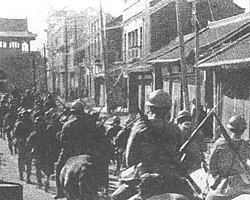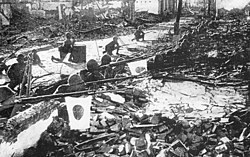Second Sino-Japanese War
The Second Sino-Japanese War (July 7, 1937 to September 3, 1945) was a major war fought between the Republic of China and the Empire of Japan. It became part of World War II when Japan entered that war on the side of the Axis powers. Part of the Sino-Japanese war was fought in northern Myanmar and northeastern India. The war ended when Japan surrendered after the atomic bombings of Hiroshima and Nagasaki. It started in 1937 43 years after the First Sino-Japanese War in 1894 led by Emperor Meiji who was the Grandfather of Hirohito.
Invasion of China
The Second Sino-Japanese War began when Japan invaded China in 1931. Japan used the Mukden Incident as an excuse to invade China. The invasion grew into a full-scale war after the Marco-Polo Bridge Incident. Japanese officers said that a Japanese soldier got lost and they were allowed to find him in Beiping.
Japan invaded China for a few reasons:
- Japan needed more and more raw materials to create its heavy industry and intended to get them by taking over more of Asia
- The Japanese military, and Japanese nationalism, were becoming stronger and more popular
While the Imperial Japanese Army was trying to take over China, the KMT (the Nationalist Government under Chiang Kai-Shek) and the CPC (Communist Party of China under Mao Zedong) cooperated a little to try to fight off Japan together. This was called the "Chinese United Front". However, for the most part, they continued to fight each other as well.
Japanese occupation of China
In 1931, the Imperial Japanese Army began to occupy China, starting in the northeast (Manchuria), where they created a puppet state called Manchukuo. In 1937, they occupied Beiping (now called Beijing), and then Nanjing. For six weeks in Nanjing, the army committed the Nanjing Massacre. During this massacre, Japanese soldiers killed between 40,000 and 300,000 Chinese people,[1][2] and raped at least 20,000 women and girls.[2]
After six weeks, the Japanese Army left Nanjing. It finally occupied the industrial cities in southern China. Chiang moved his capital city from Nanjing to Chongqing, and began a tactic of "using space to trade for time." He was able to spread Japanese soldiers out too thin. This means they were covering too much space with too few soldiers. This made them harder to fight, and made it easier for partisans to fight back in occupied China.
Many soldiers died on both sides at this time. However, in 1940, the Japanese Army stopped being able to move farther into China and take more land. 1940 also marked the point where China began to be able to fight back, instead of Japan continuing to take over the country.
End of the war 1941-1945
After Japan bombed Pearl Harbor in the United States on December 7, 1941, the Second Sino-Japanese War became part of World War II. It became a part of the area of fighting called the China-Burma-India theatre. The entrance of the United States into the war in Asia meant that the Chinese military forces started receiving lend-lease supplies from the British and Americans over the Burma Road. This helped the Chinese fight back and get much-needed modern weapons.
The Second Sino-Japanese War had damaged Japan. It had not been able to win the war against China quickly. Instead, Japan's military had already been fighting China for four years. This made it much more difficult for Japan to keep fighting (now in the Pacific against the Allied forces). This may have been one reason why Japan eventually lost the war.
In China, the war had some important effects. It made more people support the Chinese Communist Party. It also made Chiang's Republic fall apart more quickly, in 1949.
Second Sino-Japanese War Media
Generalissimo Chiang Kai-shek, Allied Commander-in-Chief in the China theatre from 1942 to 1945
The movie is produced by the US Army Signal Corps in the 1930s (1)Beginning of the war.
Japanese troops entering Shenyang during the Mukden Incident
Japanese Empire's territorial expansion
Generalissimo Chiang Kai-shek announced the Kuomintang policy of resistance against Japan at Lushan on 10 July 1937, three days after the Marco Polo Bridge Incident.
A baby sits in the remains of a Shanghai train station on 'Bloody Saturday', 1937
On 18 February 1943, Madame Chiang Kai-shek addressed both houses of the US Congress.
US Air Forces video: Flying Tigers Bite Back
Related pages
References
- ↑ Wakabayashi, Bob Tadashi, ed. (2008). The Nanking Atrocity, 1937–38: Complicating the Picture. Berghahn Books. p. 362. ISBN 978-1845451806.
- ↑ 2.0 2.1 Judgment (English Translation): Chapter VIII, Conventional War Crimes (Atrocities). International Military Tribunal for the Far East. p. 1012, 1015. November 1, 1948. Retrieved April 14, 2016.







